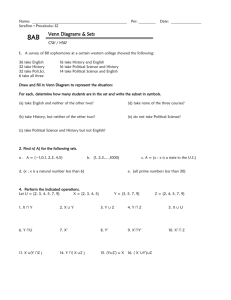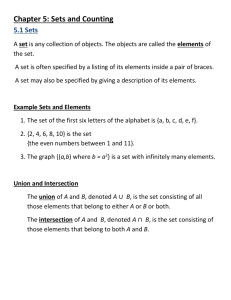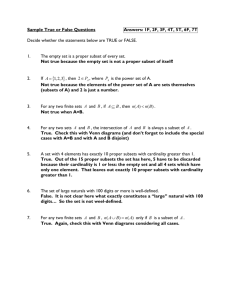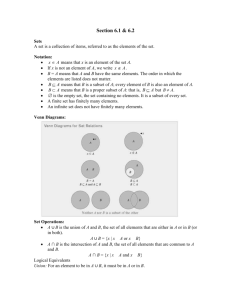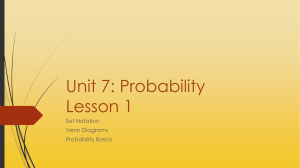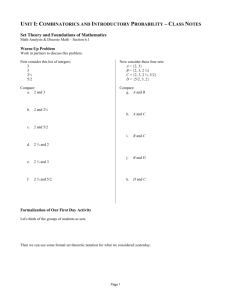Basic Concepts of Set Theory: Symbols & Terminology Defining Sets
advertisement
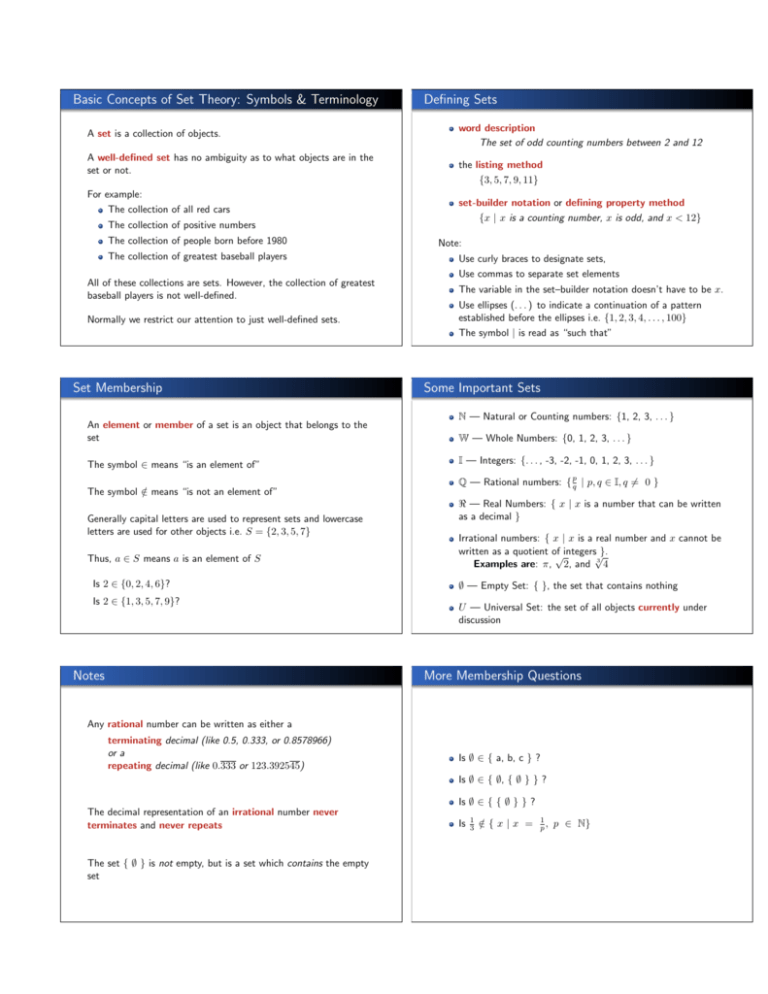
Basic Concepts of Set Theory: Symbols & Terminology
A set is a collection of objects.
A well-defined set has no ambiguity as to what objects are in the
set or not.
For example:
The collection of all red cars
The collection of positive numbers
The collection of people born before 1980
The collection of greatest baseball players
All of these collections are sets. However, the collection of greatest
baseball players is not well-defined.
Normally we restrict our attention to just well-defined sets.
Defining Sets
word description
The set of odd counting numbers between 2 and 12
the listing method
{3, 5, 7, 9, 11}
set-builder notation or defining property method
{x | x is a counting number, x is odd, and x < 12}
Note:
Use curly braces to designate sets,
Use commas to separate set elements
The variable in the set–builder notation doesn’t have to be x.
Use ellipses (. . . ) to indicate a continuation of a pattern
established before the ellipses i.e. {1, 2, 3, 4, . . . , 100}
The symbol | is read as “such that”
Set Membership
An element or member of a set is an object that belongs to the
set
The symbol ∈ means “is an element of”
The symbol ∈
/ means “is not an element of”
Generally capital letters are used to represent sets and lowercase
letters are used for other objects i.e. S = {2, 3, 5, 7}
Thus, a ∈ S means a is an element of S
Is 2 ∈ {0, 2, 4, 6}?
Is 2 ∈ {1, 3, 5, 7, 9}?
Notes
Some Important Sets
N — Natural or Counting numbers: {1, 2, 3, . . . }
W — Whole Numbers: {0, 1, 2, 3, . . . }
I — Integers: {. . . , -3, -2, -1, 0, 1, 2, 3, . . . }
Q — Rational numbers: { pq | p, q ∈ I, q 6= 0 }
< — Real Numbers: { x | x is a number that can be written
as a decimal }
Irrational numbers: { x | x is a real number and x cannot be
written as a quotient of√integers√}.
Examples are: π, 2, and 3 4
∅ — Empty Set: { }, the set that contains nothing
U — Universal Set: the set of all objects currently under
discussion
More Membership Questions
Any rational number can be written as either a
terminating decimal (like 0.5, 0.333, or 0.8578966)
or a
repeating decimal (like 0.333 or 123.392545)
Is ∅ ∈ { a, b, c } ?
Is ∅ ∈ { ∅, { ∅ } } ?
Is ∅ ∈ { { ∅ } } ?
The decimal representation of an irrational number never
terminates and never repeats
The set { ∅ } is not empty, but is a set which contains the empty
set
Is
1
3
∈
/{x|x =
1
p,
p ∈ N}
Set Cardinality
Set Cardinality
The cardinality of a set is the number of distinct elements in the
set
The cardinality of a set A is denoted n(A) or |A|
If the cardinality of a set is a particular whole number, we call
that set a finite set
If a set is so large that there is no such number, it is called an
infinite set (there is a precise definition of infinity but that is
beyond the scope of this course)
Note: Sets do not care about the order or how many times an
object is included. Thus, {1, 2, 3, 4}, {2, 3, 1, 4}, and
{1, 2, 2, 3, 3, 3, 4, 4} all describe the same set.
Set Equality
A = {3, 5, 7, 9, 11}, B = {2, 4, 6, . . . , 100}, C = {1, 3, 5, 7, . . . }
D = {1, 2, 3, 2, 1}, E = {x | x is odd, and x < 12}
n(A) = ?
n(B) = ?
n(C) = ?
n(D) = ?
n(E) = ?
Venn Diagrams & Subsets
Set Equality: the sets A and B are equal (written A = B)
provided:
1. every element of A is an element of B, and
Universe of Discourse – the set containing all elements under
discussion for a particular problem
In mathematics, this is called the universal set and is denoted by
U
Venn diagrams can be used to represent sets and their
relationships to each other
2. every element of B is an element of A
In other words, if and only if they contain exactly the same
elements
{ a, b, c } = { b, c, a } = { a, b, a, b, c } ?
{ 3 } = { x | x ∈ N and 1 < x < 5} ?
{ x | x ∈ N and x < 0} = { y | y ∈ Q and y is irrational} ?
Venn Diagrams
A
U
The Complement of a Set
The “Universe” is represented by the rectangle
Sets are represented with circles, shaded regions, and other shapes
within the rectangle.
A0
A
A0
A
The set A0 , the shaded region, is the complement of A
A0 is the set of all objects in the universe of discourse that are not
elements of A
A0 = {x | x ∈ U and x ∈
/ A}
Subsets
Let U = {1, 2, 3, . . . , 8}, R = {1, 2, 5, 6}, and S = {2, 4, 5, 7, 8}
Set A is a subset of set B if every element of A is also an element
of B. In other words, B contains all of the elements of A.
This is denoted A ⊆ B.
Of the sets R, S, and T shown in the Venn diagram below, which
are subsets?
What is: R0 , the complement of R ?
What is: S 0 , the complement of S ?
R
What is: U 0 , the complement of U ?
T
What is: ∅0 , the complement of ∅ ?
S
Subsets
Set Equality and Proper Subsets
Suppose U = {1, 2, 3, . . . , 8}, R = {1, 2, 5, 6}, S = {2, 4, 5, 7, 8},
and T = {2, 6}
What element(s) are in the area where all the sets overlap?
What element(s) are in the area outside all the sets?
Another definition for set equality: Sets A and B are equal if and
only if:
1. A ⊆ B and
2. B ⊆ A
R
T
Proper Subset: A ⊂ B if A ⊆ B and A 6= B
S
Is or Is Not a Subset?
Notes
Is the left set a subset of the set on the right?
{a, b, c}
{a, c, d, f }
{a, b, c}
{c, a, b}
{a, b, c}
{a, b, c}
{a}
{a, b, c}
Any set is a subset of the universal set
{a, c}
{a, b, c, d}
The empty set is a subset of every set including itself
{a, c}
{a, b, d, e, f }
X
X
∅
{a, b, c}
∅
∅
Any set is a subset of itself
Set Equality
Cardinality of the Power Set
Is the left set equal to, a proper subset of, or not a subset of
the set on the right?
Power Set: P(A) is the set of all possible subsets of the set A
For example, if A = {0, 1}, then P(A) = {∅, {0}, {1}, {0, 1}}
Find the following power sets and determine their cardinality.
{1, 2, 3}
P(∅) =
I
{a}
{a, b}
P({a}) =
{a, b}
{a}
P({a, b}) =
{a, b, c}
{a, d, e, g}
{a, b, c}
{a, a, c, b, c}
{∅}
{a, b, c}
{∅}
{}
P({a, b, c}) =
Is there a pattern?
Another Method for Generating Power Sets
Set Operations
A tree diagram can be used to generate P(A). Each element of
the set is either in a particular subset, or it’s not.
∅
In other words, for an object to be in A ∩ B it must be a member
of both A and B.
{a}
∅
{b}
∅
∅
{c}
Intersection
The intersection of two sets, A ∩ B, is the set of elements
common to both: A ∩ B = {x|x ∈ A and x ∈ B}.
{b}
{a}
{b, c}
{a}
A
{a, b}
{a, c} {a, b} {a, b, c}
B
The number of subsets of a set with cardinality n is 2n
The number of proper subsets is 2n − 1 (Why?)
Find the Following Intersections
Disjoint Sets
{a, b, c}
∩
{b, f, g}
=
{a, b, c}
∩
{a, b, c}
=
For any A, A ∩ A
=
{a, b, c}
∩
{a, b, z}
=
{a, b, c}
∩
{x, y, z}
=
{a, b, c}
∩
∅
=
For any A, A ∩ ∅
=
For any A, A ∩ U
=
For any A ⊆ B, A ∩ B
=
Disjoint sets: two sets which have no elements in common.
I.e., their intersection is empty: A ∩ B = ∅
A
B
Are the Following Sets Disjoint?
{ a, b, c }
and
{ d, e, f, g }
{ a, b, c }
and
{ a, b, c }
{ a, b, c }
and
{ a, b, z }
{ a, b, c }
and
{ x, y, z }
{ a, b, c }
and
∅
Set Union
The union of two sets, A ∪ B, is the set of elements belonging to
either of the sets: A ∪ B = {x|x ∈ A or x ∈ B}
In other words, for an object to be in A ∪ B it must be a member
of either A or B.
A
For any A, A and ∅
For any A, A and A0
B
Find the Following Unions
Set Difference
{ a, b, c }
∪
{ b, f, g }
=
{ a, b, c }
∪
{ a, b, c }
=
For any A, A ∪ A
=
{ a, b, c }
∪
{ a, b, z }
=
{ a, b, c }
∪
{ x, y, z }
=
{ a, b, c }
∪
∅
=
For any A, A ∪ ∅
=
For any A, A ∪ U
=
For any A ⊆ B, A ∪ B
=
The difference of two sets, A − B, is the set of elements belonging
to set A and not to set B: A − B = {x|x ∈ A and x ∈
/ B}
A
B
Note: x ∈
/ B means x ∈ B 0
Thus, A − B = {x|x ∈ A and x ∈ B 0 }
= A ∩ B0
Set Difference Example
{1, 2, 3, 4, 5} − {2, 4, 6} =
Given the
U =
A =
B =
C =
sets:
{1, 2, 3, 4, 5, 6, 9}
{1, 2, 3, 4}
{2, 4, 6}
{1, 3, 6, 9}
Find each of these sets:
{2, 4, 6} − {1, 2, 3, 4, 5} =
A∪B =
A∩B =
Note, in general, A − B 6= B − A
A∩U =
A∪U =
Describe the Following Sets in Words
Given the sets:
U = {1, 2, 3, 4, 5, 6, 9}
A = {1, 2, 3, 4}
B = {2, 4, 6}
C = {1, 3, 6, 9}
Find each of these sets:
A0 ∪ B 0 =
A0 =
A0 ∩ B 0 =
A0 ∩ B =
A ∩ (B ∪ C) =
A0 ∪ B =
A∪B∪C =
(A0 ∪ C) ∩ B =
A∩B∩C =
Set Operations
Given the
U =
A =
B =
C =
sets:
{1, 2, 3, 4, 5, 6, 7}
{1, 2, 3, 4, 5, 6}
{2, 3, 6}
{3, 5, 7}
Finding intersections, unions, differences, and complements of sets
are examples of set operations
An operation is a rule or procedure by which one or more objects
are used to obtain another object (usually a set or number).
Common Set Operations
Let A and B be any sets, with U the universal set.
Find each set:
The complement of A is: A0 = {x|x ∈ U and x ∈
/ A}
A−B =
A0
B−A=
A
(A − B) ∪ C 0 =
Set Intersection and Union
Set Difference
The intersection of A and B is:
A ∩ B = {x|x ∈ A and x ∈ B}
The difference of A and B is: A − B = {x|x ∈ A and x ∈
/ B}
A
B
The union of A and B is: A ∪ B = {x|x ∈ A or x ∈ B}
A
B
A
B
Suppose U = {q, r, s, t, u, v, w, x, y, z},
A = {r, s, t, i, v},
and B = {t, v, x}
Shade the Diagram for: A0 ∩ B 0 ∩ C
Complete the Venn Diagram to represent U , A, and B
A
B
A
C
B
De Morgan’s Laws
Shade the Diagram for: (A ∩ B)0
De Morgan’s Laws: For any sets A and B
A
(A ∩ B)0 = A0 ∪ B 0
(A ∪ B)0 = A0 ∩ B 0
B
Using A, B, C, ∩, ∪, −, and 0 , give a symbolic description of the
shaded area in each of the following diagrams. Is there more than
one way to describe each?
Shade the Diagram for: A0 ∪ B 0
A
A
B
A
B
B
C
Cardinal Numbers & Surveys
Counting via Venn Diagrams
Suppose,
U = The set of all students at EIU
A = The set of all male 2120 students
B = The set of all female 2120 students
A∪B =
Now suppose,
n(A) = 97
n(B) = 101
A
97
101
B
n(A ∪ B) =
C
Suppose,
U = The set of all students at EIU
A = The set of all 2120 students that own a car
B = The set of all 2120 students that own a truck
A∪B =
A∩B =
Now suppose,
n(A) = 33
n(B) = 27
n(A ∩ B) = 10
n(A ∪ B) =
A
B
Inclusion/Exclusion Principle
Back to Counting with Venn Diagrams
For any two finite sets A and B:
n(A ∪ B) = n(A) + n(B) − n(A ∩ B)
A
10
In other words, the number of elements in the union of two sets is
the sum of the number of elements in each of the sets minus the
number of elements in their intersection.
4
How many integers between 1 and 100 are divisible by 2 or 5?
A=
B=
n(A) =
n(B) =
n(A ∩ B) =
n(A ∪ B) =
0
Find the cardinality of the sets:
{n | 1 ≤ n ≤ 100 and n is divisible by 2}
{n | 1 ≤ n ≤ 100 and n is divisible by 5}
A
(A ∪ B) ∩ C
B
A0
C0
C −B
A∪B
(A ∪ B) ∩ C 0
A∩B∩
Venn Diagram for 2 Sets
1
B
2
C
5
Let,
2
3
Venn Diagram for 3 Sets
There are eight disjoint regions
There are four disjoint regions
I
II
III
I:
A
∩
B0
II:
A
∩
B
III:
A0
∩
B
IV:
A0
∩
B0
I
IV
IV
III
II
V
VI
VII
VIII
Technique for Counting with Venn Diagrams
Designate the universal set
Describe the sets of interest
I:
A
∩
B0
∩
C0
II:
A
∩
B
∩
C0
III:
A0
∩
B
∩
C0
IV:
A
∩
B0
∩
C
V:
A
∩
B
∩
C
VI:
A0
∩
B
∩
C
VII:
A0
∩
B0
∩
C
VIII:
A0
∩
B0
∩
C0
Using Venn Diagrams to Display Survey Data
Kim is a fan of the music of Paul Simon and Art Garfunkel. In her
collection of 22 CDs, she has the following:
5 on which both Simon and Garfunkel sing
8 total on which Simon sings
7 total on which Garfunkel sings
12 on which neither Simon nor Garfunkel sings
Draw a general Venn diagram
S
Relate known information to the sizes of the disjoint regions
of the diagram
G
Infer the sizes of any remaining regions
1. How many of her CDs feature only Paul Simon?
2. How many of her CDs feature only Art Garfunkel?
3. How many feature at least one of these two artists?
Love, Prison, and Trucks
There is the cliche that Country–Western songs emphasize three
basic themes: love, prison, and trucks. A survey of the local
Country–Western radio station produced the following data of
songs about:
Number
Love?
Prison?
Trucks?
12
13
28
12 truck drivers in love while in prison
13 prisoners in love
28 people in love
18 truck drivers in love
3 truck drivers in prison who are not in love
2 prisoners not in love and not driving trucks
8 people who are out of prison, are not in love, and do not
drive trucks
16 truck drivers who are not in prison
18
3
2
8
16
Catching Errors
L
Jim Donahue was a section chief for an electric utility company.
The employees in his section cut down tall trees (T ), climbed poles
(P ), and spliced wire (W ). Donahue submitted the following
report to the his manager:
P
T
n(T )
How many songs were. . .
1.
2.
3.
4.
5.
6.
Surveyed?
About truck drivers?
About prisoners?
About truck drivers in prison?
About people not in prison?
About people not in love?
n(T )
n(P )
n(W )
n(T ∩ P )
=
=
=
=
45
50
57
28
P
W
45
n(P ∩ W )
=
20
n(P )
=
50
n(T ∩ W )
=
25
n(W )
=
57
n(T ∩ P ∩ W )
=
11
n(T ∩ P )
=
28
n(T 0 ∩ P 0 ∩ W 0 )
=
9
Donahue also stated that 100 employees were included in the
report. Why did management reassign him to a new section?
n(P ∩ W )
n(T ∩ W )
n(T ∩ P ∩ W )
n(T 0 ∩ P 0 ∩ W 0 )
T
=
=
=
=
=
20
25
11
9
Jim Donahue was reassigned to the home economics department of
the electric utility company. he interviewed 140 people in a
suburban shopping center to find out some of their cooking habits.
He obtained the following results. There is a job opening in
Siberia. Should he be reassigned yet again?
58 use microwave ovens
63 use electric ranges
58 use gas ranges
19 use microwave ovens and electric ranges
17 use microwave ovens and gas ranges
4 use both gas and electric ranges
1 uses all three
2 cook only with solar energy
Student Values
M
E
Julie Ward, who sells college textbooks, interviewed freshmen on a
community college campus to determine what is important to
today’s students. She found that Wealth, Family, and Expertise
topped the list. Her findings can be summarized as:
G
n(W)
=
160
n(E ∩ F)
=
90
n(F)
=
140
n(W ∩ F ∩ E)
=
80
n(E)
=
130
n(E0 )
=
95
E)0 ]
=
10
n(W ∩ F)
=
n[(W ∪ F ∪
95
How many students were interviewed?
Counting Principles
W
F
E
A
B
C
We have three choices from A to B and two choices from B to C.
How many ways are there to get from A to C through B?
How many students were interviewed?
Multiplication Principle
Examples
If k operations (events, actions,...) are performed in succession
where:
Operation 1 can be done in n1 ways
Operation 2 can be done in n2 ways
..
.
Operation k can be done in nk ways
then the total number of ways the k operations can all be
performed is:
n1 ∗ n2 ∗ n3 ∗ · · · ∗ nk
In other words, if you have several actions to do and you must do
them all you multiply the number of choices to find the total
number of choices.
How many outcomes can there be from three flips of a coin?
Action 1:
Action 2:
Action 3:
Total
Flip a coin
Flip a coin
Flip a coin
How many ways are there to form a three letter sequence from the
letters in {A, B, C, . . . , Z}?
Action 1:
Action 2:
Action 3:
Total
Pick a letter
Pick a letter
Pick a letter
How many ways are there to form a three letter sequence from the
letters in {A, B, C, . . . , Z} without repeating any letter?
Action 1:
Action 2:
Action 3:
Total
Pick a letter
Pick an unused letter
Pick an unused letter
Counting with Trees
How many ways are there to form a license plate that starts with
three uppercase letters and end with 3 digits (0–9)?
Action 1:
Action 2:
Total
Tree diagrams consist of nodes (the circles) and branches that
connect some nodes.
Pick 3 letters
Pick 3 digits
The nodes represent the possible “states” of a situation.
Branches are the ways or “choices” we have to move to another
state.
The “top” node is called the root and it represents the starting
state.
Leaves, nodes with no other nodes under them, represent an
ending state.
Counting with Trees
Examples
How many outcomes can there be from three flips of a coin?
start
This leads to the following technique:
H
Use a tree diagram to illustrate a situation
T
Count the number of leaves to find the number of possible
outcomes
HH
HT
TH
TT
HHH HHT HTH HTT THH THT TTH TTT
8 outcomes
Addition Principle
How many ways can a best of three Chess series end. Must have a
majority to be declared victor.
If A ∩ B = ∅, then n(A ∪ B) =
.
If we are to perform one of k operations (events, actions,...)
where:
start
1
11
2
12
1T
22
Operation 1 can be done in n1 ways
Operation 2 can be done in n2 ways
..
.
T
21
2T
TT
T1
T2
Operation k can be done in nk ways
1T1 1T2 1TT
2T1 2T2 2TT
T21 T22 T2T
then the total number of choices is:
121
122 12T
211
212 21T
T11 T12 T1T
n1 + n2 + n3 + · · · + nk
21 outcomes
In other words, if you have several actions to do and you are only
going to do one of them you add the number of choices to find the
total number of choices.
Examples
You are hungry and want to order a combo meal from either Taco
Hut or Burger Lord. Taco Hut has 6 different combo meals and
Burger Lord has 9. How many choices to you have?
Action 1:
Action 2:
Total
Order a combo from Taco Hut
Order a combo from Burger Lord
You are hungry and want to order a pizza from either Pizza Place
or Pizza Hog. Pizza Place has 6 different toppings and Pizza Hog
has 9. Topping can either be on or off of a pizza. How many
choices to you have?
Action 1:
Action 2:
Total
Order a pizza from Pizza Place
Order a pizza from Pizza Hog


